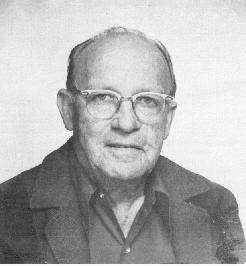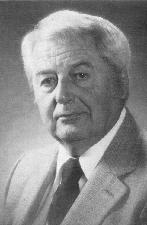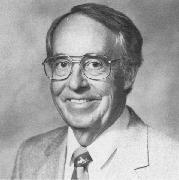1980 Honorary Life Member Selections
 THOMAS HASKELL HANKINS
THOMAS HASKELL HANKINS
Mr. Hankins was born May 14, 1908 in Hickory, Oklahoma. Shortly after birth his family moved to Texas, remaining there for ten years, and then moving to Atoka, Oklahoma, where Tom graduated from high school in 1928.
While in high school Tom became the 4-H Potato Club Champion and won a potato tour to Nebraska where he met plant pathologist, Dr. R. W. Goss, at the University of Nebraska. In 1928, after a summer of roguing potato fields for a commercial seed grower, he attended the University of Nebraska and assisted Dr. Goss in the greenhouse phase of his spindle tuber work. During the summer of 1929 he worked for the Nebraska Certified Seed Potato Growers Association Certification Division. The next year (1929-30) he returned to the university as a laboratory and field helper for Dr. Goss.
In the fall of 1930 he became a bin inspector for the State Seed Certification Agency. In the fall of 1931 he resumed his studies at the university. During the next few years he worked with the State Certification Program and continued to attend the university, and was married to Anni Walgren. In 1936 he accepted the position of Extension Potato Specialist and continued his academic studies. In 1939 he went to work for the Nebraska Certified Seed Potato Growers Association in marketing. He was sent to Louisiana as a salesman and ‘PR’ man.
In 1941 Tom came to California as manager of the Kern County Seed Potato Association. In addition to inspecting all of the White Rose seed fields in the western U.S., he was charged with working out an equitable means of financing the organization’s operations. It had been set up originally with funds supplied by the County of Kern and the Southern Pacific and Santa Fe Railroads.
The potato industry took over financial support by purchasing “Kern County Seed Potato Association Approved” tags along with the usual state certification tags. Tom and his co-workers in the Association, whose mandate was to obtain good seed potatoes for Kern County potato growers, were a very important factor in improving the quality of seed potatoes ,available in the western potato areas of the United States. In addition to seed potato field inspections they utilized a greenhouse in Bakersfield where seed potato samples were evaluated for disease content, and other abnormalities.
Tom probably was the individual most responsible for reducing the “ring rot” problem of seed potato in California. Tom was instrumental in the introduction of the Kennebec cultivar to Kern County in 1951. Except for five years (1945-1950), during which time he was engaged in a farming enterprise, Tom continued in this position until the organization was discontinued in 1965. From 1965 until his retirement in 1974 he was in charge of the seed potato production of Jim Minor’s AgriEmpire organization headquartered at San Jacinto, California.
In 1971 Anni Hankins passed away. Fortunately Tom found a lovely, gracious widow, Dorothy Miles, and they were married in 1972. Tom has always been cooperative with and supportive of the research and extension efforts of the University of California and U.S.D.A. personnel, and has never been too busy to talk with and help a potato grower with a problem, whatever its nature. He has been a member of PAA since 1936. As a voice from the potato industry he contributed to the floor discussions at many of the annual meetings presenting points of view and offering suggestions that helped strengthen the conduct of the PAA. Tom was chairman of the field trip program of the 54th Annual Meeting PAA, Riverside, CA 1970.
It is with respect and pleasure for me to present Thomas Haskall Hankins to The Potato Association of America for honorary life membership.
Herman Timm, Nominator
 GARNET RICHARD JOHNSTON
GARNET RICHARD JOHNSTON
Garnet Richard Johnston, or “Gary” as he is known throughout the North America potato world, was born in the village of Alma, near Guelph, Ontario in 1916, and raised on the family farm. He attended local public and high schools and then enrolled in the Toronto Normal School. Following graduation he taught public school until the outbreak of World War II, at which time he joined the Royal Canadian Air Force as aircrew. Following discharge in 1945, Gary enrolled in the Ontario Agricultural College (OAC) at Guelph, obtaining a Bachelor’s degree in 1949 and a Master’s in 1951, specializing in cereal chemistry.
He continued this type of work at the OAC until in 1953 he took over Norm Thompson’s position as Agriculture Canada’s potato breeder/tester seconded to the O.A.C., a position which he still holds. Gary’s primary responsibility has been to breed and/or select potato cultivars adapted to Ontario, and in his early years this consisted mainly of testing seedlings and cultivars bred at the Agriculture Canada station, Fredericton, New Brunswick and at other stations in Canada and the United States. Over the years, and mainly through attending these PAA meetings, Gary has become an important part of the network of North American potato breeders who so freely exchange both their latest information and their most promising seedlings if it appears that they might be of use to their colleagues. This cooperation has led to the release of the Fredericton-bred cultivars–Huron, York, Nipigon, Tobique and Jemseg, together with Gary’s own Trent, Rideau, Yukon Gold (Canada’s first yellow-fleshed cv.) and at least two more almost ready for licensing. Germ-plasm from the U.S., Canada, South America and Europe is included in several of these latest releases.
Also, Tiawan is presently multiplying for release a potato seedling derived from true seed from a Guelph cross. It is very heat-tolerant and resistant to bacterial wilt and should be of importance to the tropical lowlands. To test these introductions Gary established the province-wide Regional Trials, and in the early areas started the study of tuber-sizing which has been so useful in finding the fight cultivars for the early market. He has collaborated with his Agriculture Canada colleagues in improving procedures for screening and selecting early-generation seedlings in large populations, work which has led to the establishment of regional breeders rather than one national breeding center.
Gary is a founding member of the Ontario and Canadian Potato Committees and has worked hard to improve all segments of the potato industry at the research and grower level. In the last role he is a popular speaker at extension meetings and field days.
Besides being a faithful attender at PAA meetings Gary was a co-chairman of the 1973 meetings at Guelph, has served as a Director of the Association and is currently a member of the Breeding and Genetics Committee, the Site Selection Committee and the Editorial Board.
Mr. President, it is my pleasure to present Garnet Richard Johnston for Honorary Life Membership in the Potato Association of America.
R. G. Rowberry, Nominator
 WARREN TRANK
WARREN TRANK
I am pleased to present Warren Trank for Honorary Life Membership in the Potato Association of America. Warren was born July 14, 1915 at Cook, Nebraska. He completed high school at Cook in 1933. Times were pretty tough and he spent the next seven years working and paying his way through the University of Nebraska. He earned his AB Degree in Botany and Agronomy in 1940. The next two years, he continued with graduate work in Pathology and Agronomy.
Warren joined the Navy in June of I942 and spent the next three years as a naval aviator in the Pacific. Warren married Gladys M. Smith in 1944. They have three daughters–all graduates of the University of Nebraska–living in this area. Warren took additional graduate work in plant pathology at the University of Nebraska after separating from the Navy.
During the summer of 1946, Warren started his career in potatoes with Nebraska Certified Potato Growers roguing potatoes under Dr. M. W. Felton, who had just moved to Nebraska. Then he worked as a field inspector until he was appointed assistant manager of the Certification Agency in 1949. He became manager of the Foundation Seed Department of Nebraska Certified Potato Growers in 1954. He left this position in May of 1957 to become manager of the Potato Certification Association of Nebraska. His 23 years as manager have seen many changes in seed certification.
In 1958, he started increasing Virus X-free seed stocks, assisted by Dr. W. B. Allington. Guidelines for a new virus testing seed program for Nebraska were developed in the Sixties by Drs. Allington, Braake and Ball. The Certification Agency took responsibility for producing basic seed and for testing fields for virus X. By mid-1960’s, nearly half of the acreage was being virus tested.
The work of the Certification Agency and Warren Trank were one and the same during this period as he had only one good assistant most of the time to carry on 3-5 thousand acres of field inspection, bin inspection and the basic program. Usually at least 25 varieties and strains were entered for certification.
In the course of his work, variations in maturity, tuber set and vine growth were noticed; strains were then selected. Many of these varietal strains are nosy grown and shipped all over the United States by Nebraska growers. During the years, Warren has conducted many demonstrations, sending seed samples to many southern states.
Warren has been active in The Potato Association of America, attending most of the meetings in the last 25 years. He was on the committee that set up the first winter meetings of State and Canadian Potato Certification officials which evolved into the Certification section of the PAA. He served as Secretary-Treasurer for a number of years and Chairman for one term.
It is an honor for me to present Warren A. Trank for Honorary Life Membership in the Potato Association of America.
Gene Shaver, Nominator
 RAYMON E. WEBB
RAYMON E. WEBB
It is an honor and pleasure to present Dr. Raymon (Ray) E. Webb for the award of Honorary Life Membership in the Potato Association of America.
Ray spent his early years on the family farm in northern Louisiana. Following graduation from high school at Farmersville, Louisiana, he attended Louisiana State University, specializing in horticulture. There he met and later married Mary Virginia O’Brien. They have three children– Mary Ann, Ray, Jr., and John.
Ray devoted three and one half years in the defense of his country in World War II as a combat soldier in the 5th U.S. Infantry Division in the European Theatre of Operations, during which time he attained the rank of captain. On his return from the service, Ray joined the Horticulture Department staff of Louisiana State University as Assistant Horticulturist in vegetable and fruit crops research at a Branch Station at Calhoun, Louisiana. In 1947, he returned to the Horticulture Department on the Baton Rouge Campus to continue his education. In 1948, he received his M.S. degree in Horticulture with a minor in botany-plant pathology and rejoined the horticultural professional staff to implement the developing Louisiana-South Dakota cooperative potato breeding program.
During 1950-52, while on leave from Louisiana State University, Ray attended the University of Wisconsin where he received a Ph.D. degree in plant pathology. Concurrently, he continued the South Dakota phase of the cooperative potato breeding program. From that program, the varieties Red La Soda, La Chipper, and La Rouge evolved.
In 1953, he joined the U.S. Department of Agriculture at what was then called the Plant Industry Station, Beltsville, Maryland. The Station, now known as the Beltsville Agricultural Research Center (BARC), is still his home. Since joining the Department in 1953, his responsibilities have included the position of Plant Pathologist, in which he did disease resistance evaluation research for the national potato breeding program headed by F.J. Stevenson and later by Robert Akeley. In 1960, Ray became leader of the Tomato and Cucurbit Investigations of the Agricultural Research Service with the charge of developing an Eastern program of research on developing pest resistant, high quality tomato varieties suited to mechanization of the harvest, and regional programs on improving vegetable transplants in the Southeast; control of the crown blight disease of cantaloupe in the Southwest; and tomato curly top disease through breeding in the West. Ray recruited and supported the scientific personnel who successfully implemented the various programs.
For his notable contributions toward developing multi-pest resistant tomato varieties suited to mechanical harvesting in the East and Midwest, disease resistant spinach varieties and hybrids, and multi-pest resistant cantaloupe breeding lines, he was presented the Superior Service Award of the USDA.
In 1969, Ray was asked to accept the responsibility of leader of the ARS Potato Investigations upon the retirement of Robert Akeley. Following the reorganization of ARS to the Science and Education Administration, Agricultural Research in 1972, he became Chief, Vegetable Laboratory, BARC, with a staff of 11 professionals, involving five scientific disciplines. Strong interdisciplinary team-commodity relationships exist in the Laboratory, including Ray and four other scientists doing related research on potato improvement, particularly, for the eastern United States.
Ray is widely recognized for his expertise on vegetable and potato improvement, which has led to requests for his services through the Agency for International Development in Central America and Asia and for materials he developed by many researchers around the world.
Ray has been unusually successful in organizing research programs relevant to the high priority needs of the vegetable and potato production communities and attracting highly motivated scientific and industry cooperation to successfully attain research objectives, i.e. developing russet and round white potato varieties for the East, which include Atlantic, Belchip, BelRus, Russette, and Oceania to date. Also, techniques and materials he has developed to improve efficiency and effectiveness in attaining his research goals have been most helpful to many other researchers. Ray has published over 150 scientific research articles. In 1976, in recognition of his scientific accomplishments and service to agriculture, Ray was elected to membership in the Cosmos Club, Washington, D.C.
Ray invited this Association to hold its annual meetings at Beltsville in 1957 and 1977 and served as local arrangements chairman at both meetings. He has been a member of the Breeding and Genetics and Plant Pathology Sections of the Association for several years.
Mr. President, I am privileged to present Raymon E. Webb as a candidate for Honorary Life Membership in the Potato Association of America, a distinct honor which he rightfully deserves for his dedication toward the welfare of the potato production industry in particular and vegetable industry in general.
Robert W. Goth, William G. Hoyman, Nominator